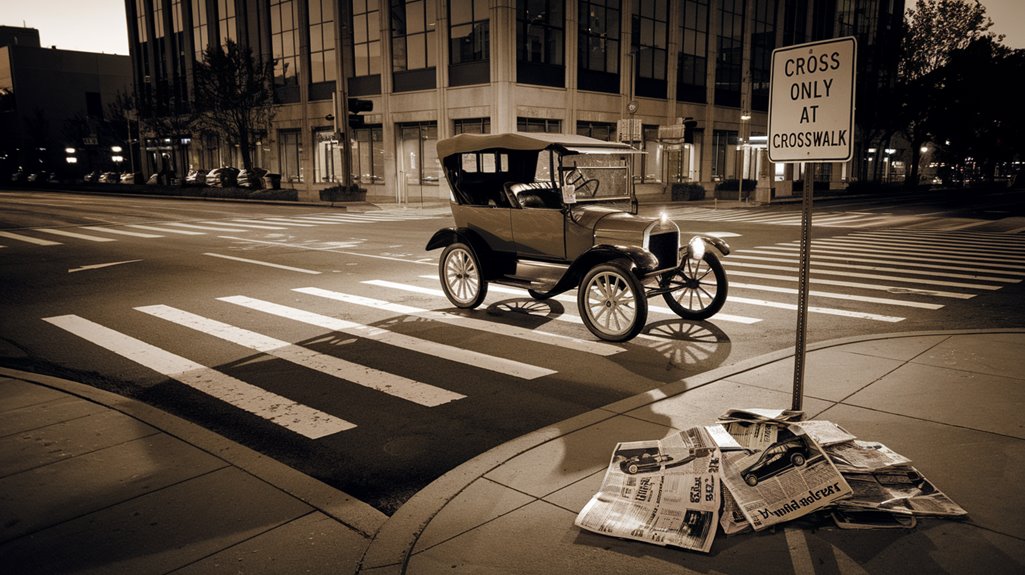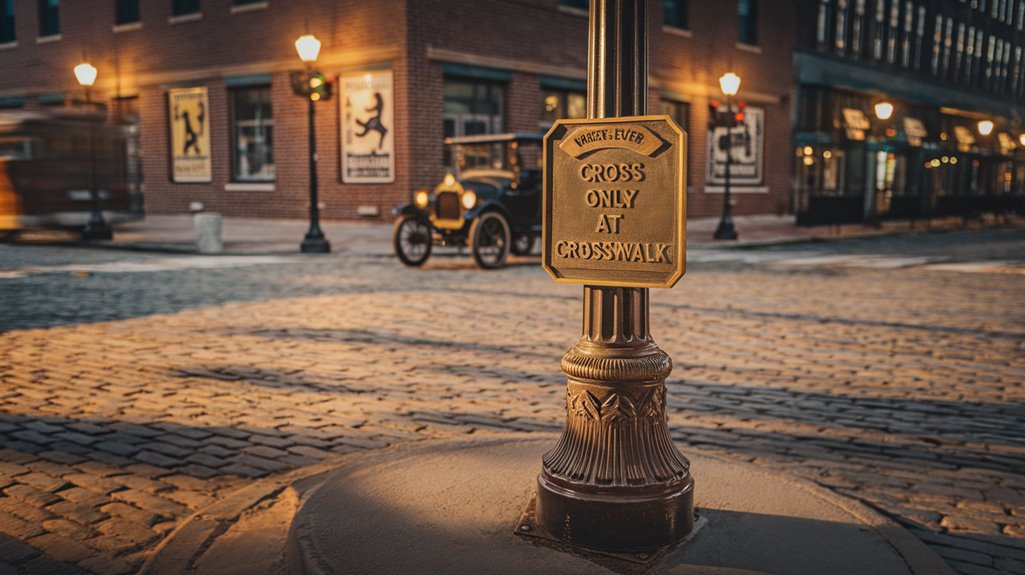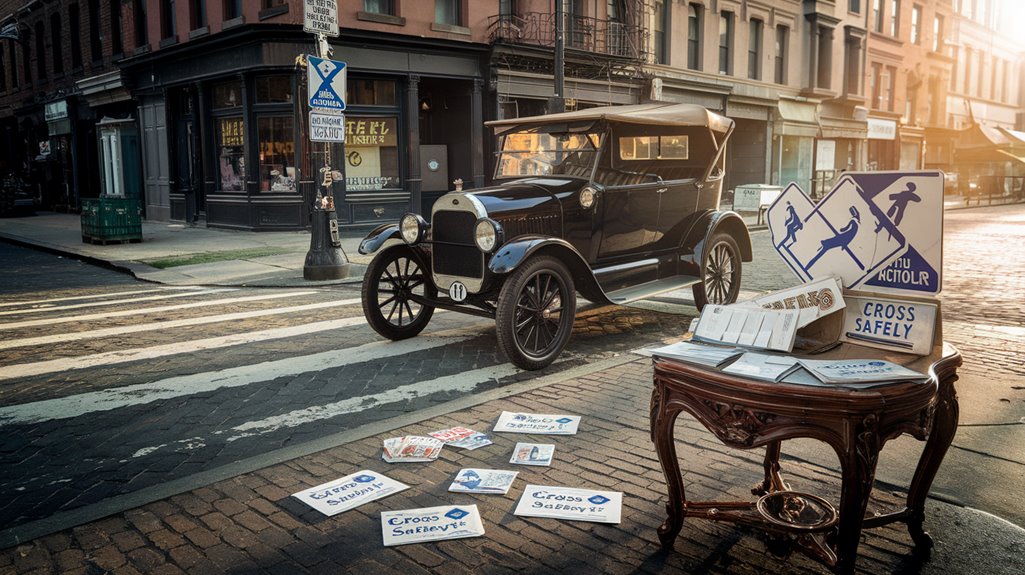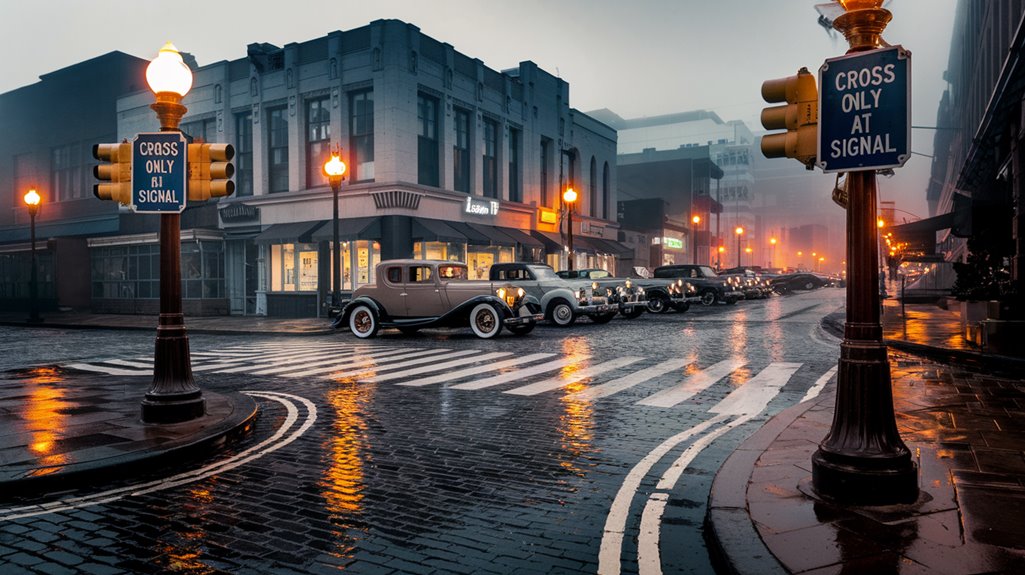The Lobbying Trick That Blamed Pedestrians—Inventing ‘Jaywalking
Like a masterful chess player positioning their pieces, the automotive industry orchestrated one of history's most effective PR campaigns when they invented the concept of "jaywalking." You've probably never questioned why crossing the street became a crime, but there's a fascinating story of corporate manipulation behind this everyday term. As you navigate your city's crosswalks today, you're walking through the legacy of a calculated early 20th-century scheme that changed how we view our rights to public spaces.
The Birth of a Blame Game

While city streets were once shared spaces where pedestrians and horse-drawn carriages coexisted peacefully, the rise of automobiles in the early 20th century sparked a calculated campaign to redefine urban mobility.
As cars became deadlier, killing over 200,000 Americans in the 1920s, the automotive industry orchestrated a masterful blame attribution strategy. The term emerged from "jay-drivers" who were criticized for driving carriages and cars incorrectly on the wrong side of the road. In 1911, the nation saw its first U.S. crosswalk installed.
You'd be surprised to learn how the National Automobile Chamber of Commerce manipulated public opinion by distributing free accident statistics to newspapers, shifting responsibility from drivers to pedestrians.
They even hired actors to mock "jaywalkers" in public shows, wearing outdated clothing to ridicule those who dared cross streets freely.
This concentrated effort transformed pedestrian rights overnight, turning shared urban spaces into car-dominated thoroughfares and forever changing how you navigate city streets.
Streets Before Cars: A Different World
Before the automotive industry's influence campaign transformed city streets, urban spaces looked remarkably different from what you see today.
You'd find vibrant communal spaces where pedestrian rights weren't just protected—they were assumed. Streets served multiple purposes, functioning as marketplaces, playgrounds, and social gathering spots. This design naturally promoted physical and mental wellbeing among city residents.
In this world of urban coexistence, you'd see a mix of horse-drawn carts, electric streetcars, vendors, and pedestrians sharing the space naturally. When automobiles first appeared, they were seen as dangerous intruders on these communal spaces.
Cities like Boston were built with walkability in mind, featuring dense neighborhoods where everything you needed was within reach.
You could cross the street wherever you wanted, as crosswalks didn't exist until 1911. The streets weren't just transportation corridors; they were living spaces where residential, commercial, and recreational activities blended seamlessly together.
The Auto Industry's Marketing Campaign
During the early 20th century, the automotive industry orchestrated one of history's most effective marketing campaigns to transform America's streets.
You'll find it hard to believe how auto advertising systematically shifted blame from drivers to pedestrians through calculated tactics.
The industry hired actors dressed in old-fashioned clothing to illegally cross streets, making the behavior seem outdated. They staged public demonstrations, including a clown being repeatedly "hit" by cars, to mock those who didn't use crosswalks.
Streets once functioned as shared spaces for multiple activities before cars dominated the landscape.
The first documented use of jaywalking appeared in The Kansas City Star newspaper in 1909.
To reinforce their message about pedestrian safety, they fed carefully crafted statistics to newspapers and influenced the creation of new traffic laws.
The campaign's centerpiece was coining the term "jaywalker" – a deliberate attempt to shame pedestrians who crossed streets outside designated areas.
You're still seeing its effects today.
Legal Changes and Social Consequences
As cities across America reexamine their jaywalking laws, a wave of reform is challenging century-old restrictions on pedestrian movement. You'll find Virginia leading this change, becoming the first state to decriminalize jaywalking in 2021, with Nevada and several cities following suit. California's Freedom to Walk Act now gives law enforcement discretion when issuing jaywalking citations. Twelve million Americans now live in jurisdictions where jaywalking has been decriminalized.
The legal implications of these reforms address a troubling pattern of social justice concerns. You might be shocked to learn that over 90% of jaywalking tickets in New York City target Black and Latine residents.
These laws have long served as a pretext for discriminatory police stops, particularly affecting marginalized communities. Instead of focusing on enforcement, you'll see cities shifting toward infrastructure improvements – redesigning streets, adding crosswalks, and slowing traffic – as more effective ways to guarantee pedestrian safety while promoting equity.
Debunking Safety Myths With Statistics

Popular misconceptions about jaywalking safety crumble when confronted with hard data.
You'll find that 75% of pedestrian fatalities occur at non-intersection locations, yet crosswalks don't provide additional protection. Urban infrastructure plays a vital role, as 85% of pedestrian deaths happen in cities, with a startling 61% increase since 2013. Major roads excluding interstates account for sixty percent of fatalities.
Pedestrians often make rational crossing decisions based on their immediate safety needs and environmental conditions.
Contrary to popular belief, it's not reckless jaywalkers who are most at risk. Data shows that children, elderly, and intoxicated individuals face higher fatality rates.
The real threats to pedestrian safety are inadequate lighting (78% of deaths occur in darkness), alcohol involvement (48% of fatal crashes), and dangerous road design.
State-owned roads in metro areas account for 66% of traffic deaths, highlighting how engineering solutions like refuge islands, improved lighting, and lower speed limits could save lives.
Moving Forward: Rethinking Urban Spaces
With cities evolving beyond car-centric planning, urban spaces are undergoing a radical transformation toward human-centered design.
 Geographic Information Systems help planners analyze and optimize street layouts for improved walkability and safety.
Geographic Information Systems help planners analyze and optimize street layouts for improved walkability and safety.
Modern urban design recognizes that community engagement is essential for success. When you involve local residents in the planning process, you're more likely to create spaces that reflect their needs and cultural values. The addition of urban furniture helps transform previously inactive spaces into vibrant community gathering spots.
Cities are now integrating natural elements like community gardens and green spaces, which not only promote mental well-being but also encourage social interaction.
You'll see these changes reflected in flexible street designs that adapt to changing scenarios, supported by advanced tools that predict pedestrian movement patterns and help create more sustainable, people-friendly neighborhoods.










